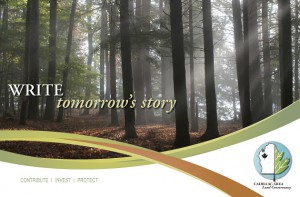The CALC Oliver Family Preserve in Harrietta has the beautiful Slagle Creek running through it and has forests and wetlands for hiking and bird watching. However the entrance to the preserve is in need of invasive species removal and a general enhancement of the grasslands to include more native grasses and wildflowers. To that end, a controlled burn is planned. To understand why a controlled burn is needed, please see Dave Foley’s Cadillac News article describing controlled burns. If you drive by the CALC Oliver Family Preserve in Harrietta and see scorched grasses, you will now understand the why behind it.
A controlled burn uses fire to improve the environment
By Dave Foley
When I’m the woods, any fire I encounter outside a campfire ring can be disconcerting and as I watched flames leap up behind firemen as they set a grassy field on fire, initially I couldn’t help but feel uneasy. But I shouldn’t have worried. What I was seeing was a controlled or prescribed burn. Bob Hess, a retired DNR wildlife biologist, was having three fields totaling about 20 acres set on fire on the land he owns near the village of Luther. When I asked Hess about the burning he replied,
“Simply put, we’re using fire to improve wildlife habitat. In cooperation with the U.S. Fish and Wildlife Services’ ‘Partners-for-Wildlife’ program, old fields were planted to native grasses and native wildflowers. Fire rejuvenates this prairie-like habitat for animals as well as grassland birds and insects, small mammals, turkeys, deer, and birds-of-prey. The ashes also enrich the soils.”
As we talked several men walked along the edges of the field, carrying metal canisters dripping a stream of combustible liquid which ignited the grass behind them. By facing into the wind, they were just a step ahead of the flames, yet completely safe. The lines of brilliant orange flame dancing above the ground, the clouds of smoke shooting across the field, and the shimmering heat of the fire created a spectacular scene, but seeing how close the fire was to a stand of red pine made me apprehensive. The edge of the burning field was separated from the pines by just the width of a two track road, yet the wind kept the ash out of the pine stand and bent the flames away from the trees. Having the wind blowing in the right direction is critical to the safety and success of a prescribed burn. This burn had been scheduled and canceled three times in the last two weeks while waiting for a favorable wind.
By making use of the wind to control where the fire will move, the crew systematically lays lines of fire in a pattern that will incinerate the grasses in the field without scorching the surrounding lands. In addition, The Luther Village Fire Department assisted and used the burn as training for fighting wildfires. One of their trucks was driving slowly along the edge of the road spraying water over the hot ash in the field providing further insurance that the pines would be safe.
For photographers, the striking images of dancing flames and smoke billowing over the land was irresistible and begged to be digitally preserved. I wasn’t the only one carrying a camera as I noticed three others with lens pointed at the fire as well. I was told that when burning fields of taller grasses, occasionally deer, rabbits, and various rodents that had been hiding in the vegetation could be seen fleeing the fire. Today all we saw was a long blue racer snake draped in the branches of a shrub. The snake posed, it’s head held high, while three cameras leaned in to capture the moment.
The disruption for the creatures living here will be relatively brief. The rains that drenched the area in the two days following the burn will bring forth new grasses and allow the wild flowers to bloom here again. In a month it will be hard to tell that these acres were burned. A prescribed burn merely replicates a natural process. In the wilderness, fire is a part of the natural order. The periodic burning of a forest removes the dead woody debris which, if not incinerated, would provide an abundance of fuel leading to an even more devastating conflagration. The policy, commonly followed by government agencies to immediately respond to and extinguish fires, allows the deadwood fuel to accumulate until so much is available, that when ignited, the results are catastrophic.
The term “controlled burn” is an apt description of what I was seeing in the fields near Luther. Nothing is left to chance. This operation was coordinated by Kanouse Outdoor Restoration and Steve Cross a retired DNR district fire supervisor; these individuals have been trained to be make sure the fire is contained within the prescribed burn area. A prescribed burn fills a function that happens naturally and helps maintain the ecological health of the land, but without the chaos that is associated with forest fires. As a result of these burnings, native wildlife, the local fire department, the landowner, and the public that enjoys wildlife are all beneficiaries.”

 124 ½ N Mitchell Suite 115
Cadillac, MI 49601
(231) 775-3631
124 ½ N Mitchell Suite 115
Cadillac, MI 49601
(231) 775-3631